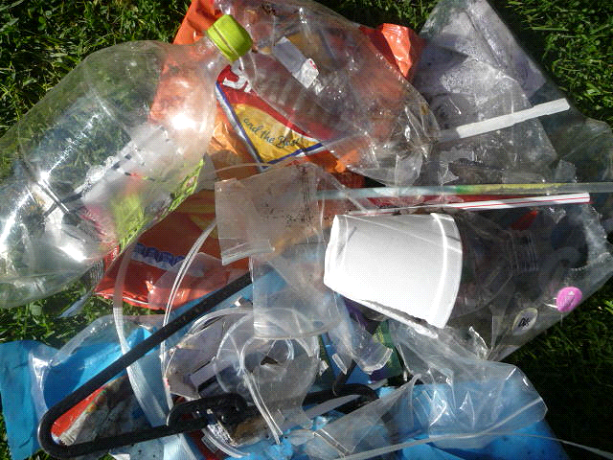Plastics, human health and environmental impacts: The road ahead Journalist’s Resource: Research for Reporting, from Harvard Shorenstein Center
Posted on October 12, 2014 by DrRossH in Plastic Waste NewsBecause of the omnipresence of plastics, the complexity of the substances that they release into the environment and the potential interaction of these substances, many questions exist on the safety of plastics for humans and the environment: Detectable levels of bisephenol A (BPA) from plastics have been found in urine of 95% of adults in the United States. While the U.S. Food and Drug Administration approves the use of bisephenol A (BPA) for most food applications, in July 2012 the FDA amended its regulations to disallow the use of BPA in baby bottles, sippy cups and formula packaging. (Note: the reasons have a complicated bureaucratic and chemical industry backstory; the FDA, which continues to update its policies, notes that the “scientific field is evolving rapidly.”) A 2010 study in the Annual Review of Public Health found that BPA has endocrine-disrupting properties. Tests indicate the possibility of health risks such as early sexual maturation, decreased male fertility and aggressive behavior. However, “the health risks of BPA are fiercely debated and, after more than 70 years of study, are still not fully understood. The stakes are high because exposure is ubiquitous and BPA-containing products are a multi-billion-dollar enterprise.” di-(2-ethylhexyl)phthalate (DEHP), often used in polyvinyl chloride (PVC) products, leaches out easily and has been found to have a number of negative impacts: “Several rodent and human studies have found correlations between DEHP exposure and harmful health effects, including changes to the female and male reproductive systems, increased waist circumference and insulin resistance.” Environmental exposure to plastic-related chemical compounds does not occur in isolation but as a “cocktail effect,” with unknown cumulative impacts. Components of plastics currently being studied for their health effects include polyhalogenated flame retardants, polyfluorinated compounds (known as PFOS or PFOA) and antimicrobial compounds such as triclosan and triclocarban. Because plastics are found throughout the globe, there are effectively no populations that haven’t been exposed to them. “Studies have demonstrated the presence of steady-state concentration of plastics’ components in the human body, thereby reflecting the ongoing balance of constant exposure, metabolism and excretion of these compounds. This situation implies that in today’s plastics-enabled society, there are no control groups to be found to analyze the effects on human health from low-level, environmental exposures to plastic constituents. Everybody is being exposed to some degree at any given time from gestation through death.”

 How many people today grab a takeaway coffee cup from the local cafe to drink on the go? We don’t know, but the number must be enormous.. Most every one of the above have a plastic top that will last 100s of years. Some cafes still use plastic cups that last a similar time. Is 10 minutes of coffee worth 100s of years of trash?
These items can be seen littering our gutters and on our streets all over the place. If they were all cardboard, they would still be littered, but they would, at least, be gone in a short time.
They do not need to be made of plastic.
How many people today grab a takeaway coffee cup from the local cafe to drink on the go? We don’t know, but the number must be enormous.. Most every one of the above have a plastic top that will last 100s of years. Some cafes still use plastic cups that last a similar time. Is 10 minutes of coffee worth 100s of years of trash?
These items can be seen littering our gutters and on our streets all over the place. If they were all cardboard, they would still be littered, but they would, at least, be gone in a short time.
They do not need to be made of plastic.
 On the way home from the gym last week, a distance of about 1 km (1/2 mile), I counted the items of plastic litter on the curb as I walked. In that short distance I counted 63 pieces of plastic litter. Plastic drink bottles, bottle tops, candy wrappers, plastic film, polystyrene fragments etc. That seemed to be a lot to me. I guess it is a generational thing. Our parents would have been horrified to see that amount, whereas it seems to go unnoticed by our youth of today. In another 20 years how many pieces will there be on this stretch, -- 200? What will today’s youth think of that new amount then when they are older? Will their children be so readily accepting of a higher amount of litter?
On the way home from the gym last week, a distance of about 1 km (1/2 mile), I counted the items of plastic litter on the curb as I walked. In that short distance I counted 63 pieces of plastic litter. Plastic drink bottles, bottle tops, candy wrappers, plastic film, polystyrene fragments etc. That seemed to be a lot to me. I guess it is a generational thing. Our parents would have been horrified to see that amount, whereas it seems to go unnoticed by our youth of today. In another 20 years how many pieces will there be on this stretch, -- 200? What will today’s youth think of that new amount then when they are older? Will their children be so readily accepting of a higher amount of litter?
Discussion · No Comments
There are no responses to "Plastics, human health and environmental impacts: The road ahead Journalist’s Resource: Research for Reporting, from Harvard Shorenstein Center". Comments are closed for this post.Oops! Sorry, comments are closed at this time. Please try again later.